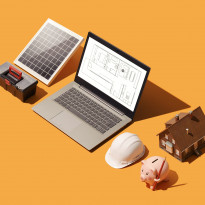We're putting the power of solar back in your hands.
Welcome to Solar
Solar energy is a modern way to power up your home, protect the environment, and lower your bills. At Self Solar, we want anyone who wants to install solar to make that choice with as much information available to them as possible. That way you can decide whether you want a team to install it or if you want a DIY project. Our goal is to make the process smooth and simple.
So let’s start with some basics!
A Quick History of Solar
Would you believe that we’ve known about photovoltaic power—the type of energy generated by solar panels—for around 150 years? Solar cells powered by Selenium generated electricity as early as 1876. The silicon-based solar panels we’re all aware of wouldn’t come around until about 1954.
Over time, we saw major increases in solar panel efficiency, which resulted in more people using them. We started seeing them used by universities, mounted on orbital satellites, and even the White House!
As with all technology, it started extremely expensive. The cost in panels to generate a single watt back in 1956 was around $300. Today, it costs about 50 cents per watt! Estimations say that, since 1980, solar panels have dropped in price by 10% every year—making it an excellent investment for every homeowner now.
How Does Solar Actually Work?
Solar power starts, as you might have guessed, with sunlight! Solar radiation excites electrons, which generate a charge. Solar panels are made up of many photovoltaic solar cells — which are 2 thin layers of silicon acting as a semiconductor.
When the sun strikes a photovoltaic cell, it excites electrons to break from their atoms and generate a direct current of energy (DC power!). But many houses operate on alternating current. That’s where an inverter on your solar system comes in and turns that DC power into AC power.
This power, generated from your solar panels through this photovoltaic effect, goes on to power…whatever you want! You can design your solar system to act as a backup energy storage for the necessities or it can power your whole home.
Are You Still on the Grid With Solar?
Many wonder if solar panels let you be completely independent from your electric company. The reality of that is a bit more complex! You can be completely independent with the right equipment, but you’ll probably need a grid-tie system, depending on your location and energy access. There are benefits and nuances to both:
Off-grid solar: This is mainly meant for remote properties that don’t have the best access to other utilities. These systems often cost more as they come with storage batteries to help generate and conserve as much energy as possible.
Grid-tied solar: A grid-tied solar system is the most cost-effective and common type of solar installed today. It aims to save money on your electric bill. By connecting to the utility company, you generate power for your home and the utility company covers the rest in the case of low power generation (or they might even pay you in the event you generate excess for the grid!).
An important thing to note about a grid-tied solar system is that it’s still susceptible to power outages. Since maintenance workers may need access to your electrical lines, your panels shut off during a power outage for safety reasons. That’s when a hybrid solar system comes into play: a grid-tied system with backup batteries.
Hybrid solar: This system comes with the benefits of perpetual power from the grid, but it also has energy storage from the batteries to keep your home running in the event of a power outage. The neighborhood power goes out, your panels turn off, but your batteries keep everything in your house on. You’re able to install the batteries for your needs—whether it’s to keep your basics on (outlets and the refrigerator) or keep your whole house on. One thing to note is that hybrid solar systems are still relatively new. Battery technology is evolving at a rapid pace and the cost is still high. If you don’t need a battery right now, it might be best to wait for the technology and pricing to improve.
Once you know the options for your solar system, it’s important to know how to purchase solar and ways to pay for it!
How You Can Purchase Solar
Solar is a big investment, but there are different approaches to consider when picking the option that’s best for you. The company you work with to install your solar will play a large part in what options are available to you.
Traditional solar companies usually come in three flavors: sales groups, installation groups, and all-in-one teams. Sales groups sell solar systems door-to-door. While this reaches many people, most sales reps are not very knowledgeable in solar, leading to misinformation and confusion. Installation groups often team up with sales groups and handle the design and installation of your solar system. With that comes all of their costs like their overhead, their labor, and margin.
All-in-one companies combine both strategies under one roof. While that may sound convenient, it can be a lot of plates to spin and these companies tend to specialize in one or the other, leaving the other half of the operation lacking.
Self Solar approaches the industry in a new way. We’ve seen the good, the bad, and the ugly and want to help you avoid all of it. By being transparent and keeping you informed, you have all the tools to approach your solar project in precisely the way you feel works best for your situation. With wholesale pricing for hardware, shipped to your door with designs at the ready, you take control of getting everything installed. Your solar, your way.
Ways You Can Purchase Solar
As with most big investments, there are multiple ways to pay for your solar system. We’ll list the most common options in order of what provides the best return on your investment.
Cash: One of the quickest ways to own your solar system and avoid high interest and finance fees is to pay for it with cash. Owning your solar system from day one allows you to see a return on that investment immediately as you generate your power and save money on your electric bills for decades to come.
2nd Mortgage or HELOC Credit: Mortgage programs under Fannie Mae and Freddie Mac allow for second mortgages where you can pay for your solar system as part of your mortgage loan on top of potentially lower interest rates. Another option called a Home Equity Line of Credit is a secured loan tied to your home equity to keep interest rates low.
Financing: Financing your solar system through a solar loan is another way to go solar without having to find a lump sum of cash. Depending on the monthly payments, it may end up costing less than your electric bill anyway. Plus, you still can claim the Federal Tax Credit for a solar system even if you’re paying to own through a loan.
While this may seem easy, it is vital to be aware of any hidden fees you might not notice at first. Since solar loans are largely unsecured, many banks and financing firms charge upfront points to compensate for the risk. These fees aren’t usually disclosed and can be as high as 25% of the total cost of the system. Combine that with increased interest rates and other fees, and you’ll see why it’s always a good idea to understand the complexities of any solar loan you sign up for.
Power Purchase Agreements: Some companies offer to lease a solar system to you. They’ll come to your home, install the system, and keep it maintained through its lifetime. The caveat here is that you do not own the system, nor do you qualify for any tax credits—the company leasing you the system does. In exchange, you pay them a fixed amount for the power that the system generates. This is no longer a common method but can apply to you in certain circumstances.
Traditional companies like sales groups, installation groups, or all-in-one groups often offer two of these options—cash and financing. At Self Solar, we want to help you know exactly what each option offers, and which ones apply best to your situation, and provide you the avenues to the one you choose.
Once you decide on all your solar system options, all that’s left is plugging into the grid (if you’re on one!).
Utility Agreements Once You’re Installed
There are different ways to measure how much energy you pull from the grid and how much energy you produce for it. Depending on your utility company, there are different ways they may compensate you for it as well.
Net Metering: Anytime you use more power than you generate (like on stormy days or at night), your utility company will still bill you for that. On the other side of that coin, any power you generate in excess goes back to the grid. Depending on the net metering policy, utility companies may credit that surplus back to you at a retail rate.
Feed-in Tariffs: FiTs are renewable energy incentive programs designed to make your financial gain off these systems more reliable. A utility company will install two meters—one for the excess power you produce and the other for the power you pull from the grid—and offer fixed rate payments and prices for outgoing and incoming energy.
Net Billing: Net billing is a method that is similar to net metering but instead of the same retail rate for incoming and outgoing energy, they are set at different rates—often charging retail prices for incoming and paying wholesale prices for outgoing. Depending on the agreement, there may not be a chance for rollover credits like net metering.
When you’re considering solar, it’s important to consider the kinds of utility agreements your local utility company offers and the way you will be compensated for the power you generate. We can do this for you with our Solar Assessment.
Deciding if Solar is Right for You
This might sound like a lot. There are financial options, weather patterns, and power usage needs for you to consider. But solar power offers you the chance to own your power, invest in clean energy, and lower your electric bills.
When it comes to deciding whether solar is right for you, it’s important to have as much information and flexibility as you can. Some traditional companies think they know what’s best for your solar needs. At Self Solar, we believe that when you have a partner who encourages, informs, and assists you—you’re the one who knows best.
Your solar, your way.
If you’re wanting to invest in solar, we’re here to help. We dive deeper into each of the subjects on the website but if you have any specific questions about your situation, you can request a Solar Assessment here for more information.
Jump to Content

